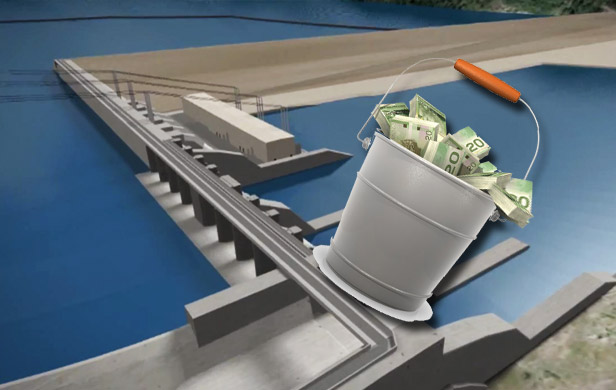
The Joint Review Panel into the $10 Billion* proposed Site C Dam released its findings on the project today.
In a summary (read full report here), it stated:
[quote]The benefits are clear. Despite high initial costs, and some uncertainty about when the power would be needed, the Project would provide a large and long – term increment of firm energy and capacity at a price that would benefit future generations. [/quote]
But there is nothing clear about the panel’s report – which leaves the waters as muddy as the banks of the mighty Peace River.
Panel offers more questions than answers
Says Andrea Morison of the Peace Valley Environment Association, “We see this as a recommendation, and there are many significant concerns that the panel has brought forward, starting with the need for the project.”
On that note, the panel conceded that BC Hydro has not adequately demonstrated the need for the project – which it clearly hasn’t. It also noted a list of unanswered environmental questions and found that “the Project would significantly affect the current use of land and resources for traditional purposes by Aboriginal peoples.”
Locating the dam within the broad web of industrial activities which already cover the region – with many more on the horizon – the panel stated, “whether the Project proceeds or not, there is a need for a government-led regional environmental assessment including a baseline study and the establishment of environmental thresholds for use in evaluating the effects of multiple, projects…The Panel recommends that the Canadian Environmental Assessment Agency undertake, on an urgent basis, an update of its guidance on cumulative effects assessment.”
And yet, in the big picture, the review held up the project as a net environmental benefit – apparently favouring its purported climate benefits over the obvious ecological impacts it carries. “It would do this in a way that would produce a vastly smaller burden of greenhouse gases than any alternative save nuclear power, which B.C. has prohibited.” Unless, of course, we don’t need the power at all…
Further complicating things is the fact that in the new era of environmental assessment in Canada, the panel itself only makes recommendations – “The decision on whether the Project proceeds is made by elected officials,” it notes. A final decision from senior levels of government on the project isn’t expected for 6 months.
This has the effect of offloading the accountability for the panel’s findings onto other parties, and it has gone the extra mile in that regard, with its “on the one hand, on the other hand” language.
That said, at first glance, the document would appear to be an overall endorsement for the project – and that’s certainly how the Liberal government will interpret it.
Panel raised hopes through hearing
The panel offered the dam’s critics some hope throughout December and January hearings in northeast BC, appearing to give proponent BC Hydro a hard time on issues ranging from the impossible challenge for citizens to engage meaningfully with its 15,000-page technical application in just one month’s time, to the utility’s dismissal of important agricultural values in the Peace River Region that would be flooded.
Yet its final verdict, for the most part, fits into a pattern of rubber stamps issued by environmental assessments for major industrial projects like the recently-approved Enbridge Northern Gateway Pipeline. As I noted in these pages following that decision, there is a troubling trend in these assessments – the inevitable conclusion that the purported economic benefits somehow outweigh the project’s impacts.
In the case of Site C, having reviewed the project closely for years now myself, it is clear that this is simply not the case. Like the Enbridge project before it, it is not incumbent on the assessor to support these conclusions with proof.
Here are 4 big reasons why the benefits of Site C do not outweigh the costs:
1. There is simply no need for the power
Throughout this latest period of Site C’s 30-year saga, we’ve heard the justification for the project morph into radically different permutations. First, we were told Site C would power 500,000 homes in BC. Except, as we’ve repeatedly demonstrated in these pages, that’s not true. BC’s power consumption has flatlined. We’re now in surplus power position for the longterm foreseeable future. Site C has nothing to do with BC’s homes.
Next, we heard it was essential to power the government’s much-vaunted liquefied natural gas (LNG) industry on the coast – a notion that was undermined by Hydro’s befuddled attempt to address LNG in its latest energy planning document. It is clear the utility has no idea how to handle LNG and Site C is but a minor, hypothetical piece of the puzzle.
Finally, during the hearing itself, the reason changed to exporting excess power to California – raising the question: how can we trust a government and utility that are continually changing their story on the dam.
Moreover, this presents a bizarre irony: At a time when we can no longer depend on cheap agricultural imports from California due to the extreme drought it faces, we are now proposing to flood some of our best farmland in order to export power to California. Go figure.
2. Flooding enough farmland to feed a million people
On that note, as the panel heard loud and clear from esteemed agrologists Wendy Holm and Evelyn Wolterson – contrary to BC Hydro’s assertions – the Peace Valley contains some of Canada’s best farmland. The 30,000-plus acre tract that would be flooded or disrupted by the dam could feed a million people. That’s a quarter of BC’s citizens. In the words of Wolterson:
[quote] It is our opinion that the public interest is better served [by] agriculture and other uses for this valley, rather than a hundred years of power production…Power has other alternatives; agriculture doesn’t.[/quote]
Good point. Too bad it fell largely on deaf ears.
3. Get ready for huge cost overruns
 Any cost-benefit analys depends partly on knowing the real cost side of the equation. Clearly, there are significant environmental and food security costs from the proposed dam, but what about the financial costs?
Any cost-benefit analys depends partly on knowing the real cost side of the equation. Clearly, there are significant environmental and food security costs from the proposed dam, but what about the financial costs?
The panel rightly acknowledged doubts about the accuracy of Hydro’s $8 Billion price tag for the project. Don’t forget, this is a government whose overseeing of large capital projects makes the NDP’s fast ferry fiasco look like the paragon of good project management. From the convention centre to the stadium roof to the Port Mann Bridge, the BC Liberal government boasts a track record of cost overruns routinely in the 50-100% range.
Couple that with the notorious inflation for dams around the world (27% on average, according to the World Bank), and we’ll call Site C $10 Billion – conservatively. This on top of deepening debt and deficits from this government – not to mention skyrocketing power bills, which will keep rising as a result of this project.
4. Serious grassroots and First Nations opposition
Local “Cowboys and Indians” – the landowners and Treaty 8 First Nations whose farms and territories would be flooded by the dam – have made it clear where they stand on this project. They’ve put themselves on the line many times before to stop the dam – and consistently won.
The panel’s ruling – muddy though it is – will likely be embraced by the Liberal Government as an approval, which puts First Nations and citizens on a path to conflict with the province in the coming months and years.
Whether it be from the lack of need for the project, the lingering geotechnical challenges it faces (though they won’t admit it, Hydro still doesn’t really know how to build the thing), the financial burden it presents to a province already deeply in debt, the growing awareness of the importance of food security in an era of climate change, or the opposition it will face on the ground, this dam is still a long, long way from being built.


Damien,
The “30,000-plus acre tract that would be flooded or disrupted by the dam”—what portion of this is First Nations land and what portion belongs to them in the remainder portion of Site C area? It seems at a glance that this could be tied up in the courts for a very long time.
Well, it’s all Treaty 8 land, Gloria – not the same as unceded territories in other parts of BC. Nevertheless, the Crown swore as a part of that treaty to uphold First Nations’ ability to practice their traditions on the land. The Crown was given the ability to take some land “from time to time” for development, but one could easily argue they’ve gone far beyond that mandate – through many previous resource development projects in the region, which is already one of the world’s most heavily industrialized:
https://commonsensecanadian.ca/new-suzuki-foundation-report-staggering-industrial-impacts-peace-region-damien-gillis/
So yes, this could end up in the courts, based on a failure to properly consult First Nations and accomodate their rights.
Power not needed in BC. Power sold to California at a big loss even without factoring in cost of building Site C. Climate change makes feeding people more expensive and definitely a challenge when one never knows when to expect extreme weather. Other power sources can be found – wind…. Other agricultural land will not be found.
1-We revoked their ‘HST’.
2-We are turning their ‘Pipedream’ into a nightmare.
3-We will do the same again to keep the ‘Peace’ whole when the time comes.
Hmmmmm, one wonders how the BC Libs are going to try and “spin” this to their corperate masters advantage………..
Apparently the coming Hydro rate hikes, every year for at least the next 10 years, do not include the $8+ Billion cost of Site C. According to:
http://www.vancouversun.com/news/Hydro+rates+head+skyward+province+unveils+year+plan/9214594/story.html
That’s absolutely right, Hugh. If this thing gets built, we ain’t seen nothin yet!
If civil unrest is the only option left open to us then civil unrest it shall be. Future generations will be proud we laid our freedom on the line to do what is right. Big business cares about investors and the bottom line. Residents care about the land and the water. The land and water sustains us.